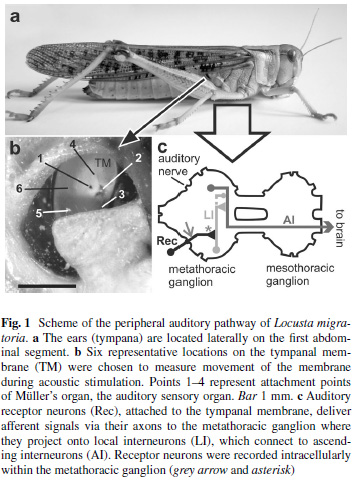Poikilothermic animals are affected by variations in environmental temperature, as the basic properties of nerve cells and muscles are altered. Nevertheless, insect sensory systems, such as the auditory system, need to function effectively over a wide range of temperatures, as sudden changes of up to 10 °C or more are common. We investigated the performance of auditory receptor neurons and properties of the tympanal membrane of Locusta migratoria in response to temperature changes. Intracellular recordings of receptors at two temperatures (21 and 28 °C) revealed a moderate increase in spike rate with a mean Q10 of 1.4. With rising temperature, the spike rate–intensity–functions exhibited small decreases in thresholds and expansions of the dynamic range, while spike durations decreased. Tympanal membrane displacement, investigated using microscanning laser vibrometry, exhibited a small temperature effect, with a Q10 of 1.2. These findings suggest that locusts are affected by shifts in temperature at the periphery of the auditory pathway, but the effects on spike rate, sensitivity, and tympanal membrane displacement are small. Robust encoding of acoustic signals by only slightly temperature-dependent receptor neurons and almost temperature-independent tympanal membrane properties might enable locusts and grasshoppers to reliably identify sounds in spite of changes of their body temperature.
Eberhard MJB*, Gordon SD*, Windmill JFC, Ronacher B. 2014. Temperature effects on the tympanal membrane and auditory receptor neurons in the locust. Journal of Comparative Physiology A. 200:837-847
* These authors contributed equally

